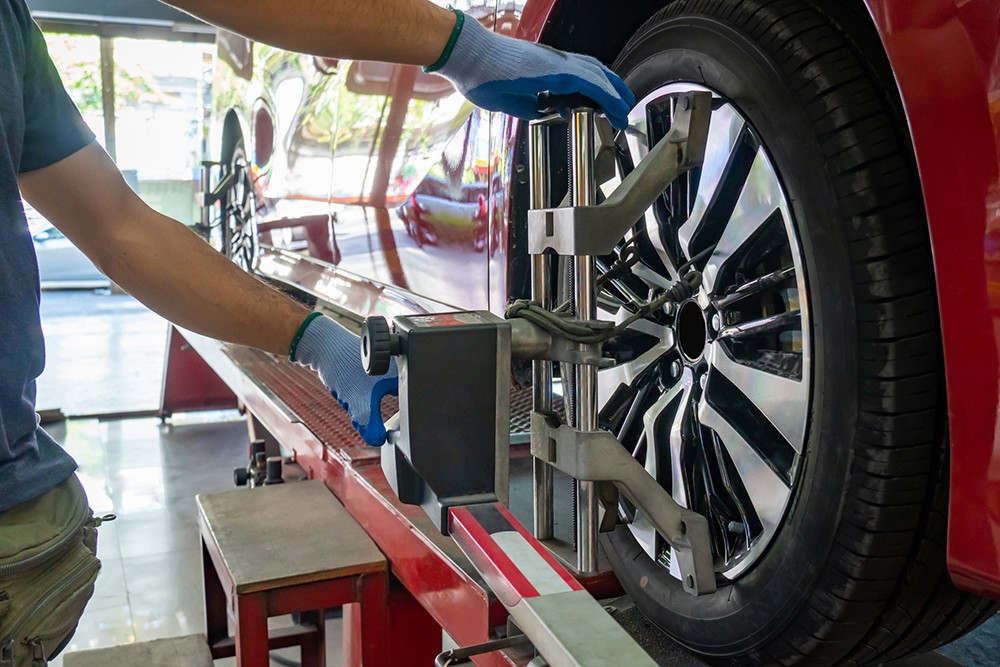Avoid Expensive Tire Damage With Inexpensive Alignment Check

Even though it might seem like nothing more than a small inconvenience when driving, overlooking indications of bad alignment can turn into major problems.
For instance, alignment issues may lead to excessive tire wear and the need for more frequent replacements. Unattended alignment issues also can cause improper vehicle control and become a dangerous problem and the cause of potential accidents.
Symptoms Of Alignment Problems
One of the most noticeable symptoms of poor alignment is that your vehicle pulls to one side or the other when driving. Another indicator is a shaky steering wheel or one that has play in the handling, as in it doesn’t feel tight and slops from side-to-side. Also, if you find steering seems to hesitate or isn’t as responsive as it could be, you may be dealing with alignment issues.
Your steering wheel position can also signal problems. Is it centered and straight as you drive or do you have to turn it to stay on the road? If the steering wheel isn’t centered when you are driving straight, this is a sign that your alignment is off.
If there are alignment issues, you may notice uneven tire tread wear and that you need to replace your tires more often. You may also have a drop in fuel efficiency because your car has to put out more power to overcome the lack of proper alignment.
What Cause Alignment Issues?
Something as simple as hitting a curb or a pothole too hard or at an extreme angle can cause your alignment to get knocked off center. If you struck debris on the roadway or had a small fender bender, this can also affect your alignment. After one of these events, it’s a good practice to check your vehicle out or take a visit to your vehicle professional for an alignment inspection and adjustment.
Over time, parts of your suspension system wear out and need to be replaced, which can lead to alignment problems. One common issue is old shock absorbers. Also, modifications to vehicles such as lifting can cause issues to the system.
What Is Wheel Alignment?
You may come across a number of different terms when it comes to the alignment of your car, such as wheel, front-end or even steering alignment. In short, these simply refer to the angle your tires connect to the road.
The goal is making adjustments to ensure that your vehicle drives as straight as possible.
When you bring your vehicle in for an alignment, your auto professional will raise it up and clamp the wheels down. Using a measuring system, the mechanic will then make specific measurements to the wheels and align them so they are true to the driving direction of the vehicle.
Auto repair techs check the angle of your wheels in respect to the road and your vehicle–known as camber, toe, and caster. They may also suggest certain parts be replaced because they are affecting the overall alignment performance.
If you have an older vehicle, you may get what is called a “front-end” alignment that only aligns the front wheels. A “thrust” alignment makes sure that all four wheels are properly aligned with each other. If you drive a 4-wheel drive vehicle, you may need a specialty alignment that addresses its unique features.
Tips for keeping your vehicle in proper alignment:
- Don’t ignore alignment issues because they can lead to much worse problems including uneven tire wear or loss of proper vehicle handling.
- If your steering wheel is off-center, has sloppy handling, or hesitation it can be a sign of alignment problems.
- Uneven tire tread wear can be a sign of alignment issues.
- Bad alignment can be caused by something as simple as hitting a pothole or curb too hard or just the wear of parts over time.
- When you bring your car in for alignment, your auto professional will measure and adjust your wheels from several different angles to ensure they are straight and true.
- You may need a different type of alignment based on the age and type of vehicle you have.